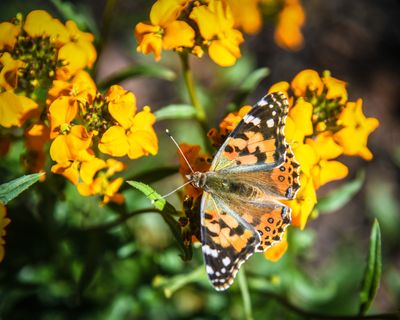Climate and wildfires threaten migrating butterflies

Painted lady butterflies will soon be on the move. They will start to migrate when temperatures cool near the Canadian border, where they spend the summer.
Each day, the butterflies, whose scientific name is Vanessa cardui, may fly 12 hours toward Mexico. They will use the sun to figure out the direction, and they will fill up on nectar from aster, ironweed and daisy flowers. They’ll lay eggs on mallow and thistle plants. The eggs will eventually become butterflies.
It is these offspring, or even the offspring of the offspring, that will keep traveling south. East Coast painted ladies will probably pass through Washington in late September. How many will you see? That depends.
East Coast painted ladies travel about 5,000 miles, says Floyd Shockley. He’s the collections manager of the entomology (insect) department at the Smithsonian National Museum of Natural History.
That’s a much shorter trip than painted ladies in Britain and the European Union make. They travel almost 9,000 miles round trip, crossing the Sahara Desert (the longest-known insect migration). But Shockley says the same things affect all populations of these butterflies and how many of them exist from year to year.
For example, new research shows that wet springs lead to the growth of more of the 300 types of flowers butterflies need for foraging (finding food) and egg-laying. More flowers mean more butterflies and more successful migrations. But much of the U.S. was hot and dry this year.
“That will impact the late-blooming flowers these butterflies need as they head toward Mexico,” Shockley says. There’s another problem: wildfires on the West Coast.
“Western painted lady populations are going to have to contend with the fact that the plants they ordinarily stop on” have burned, Shockley says. “Also, smoke clouds (block) the sun, making it difficult for them to orient. And if the fires get large enough, they create their own weather patterns” – including strong winds. Painted ladies often hitch a ride on winds, which help them fly up to 30 mph.
Wildfires, though, mean that winds could blow them in the wrong direction. “Western populations will be in real trouble this year,” Shockley says.
The good news is that the conservation status of painted ladies is stable. That means Shockley expects that if the weather improves and wildfires decline next year, the butterflies will rebound.
Still, he says there are things you can do in your backyard to help these and other butterflies, insects and birds: Plant native wildflowers, like those in the gardens at the Smithsonian. Butterflies especially like purple flowers that grow in clusters.
Shockley calls our lawns green deserts. “They are a dead zone for insects because there are no flowers,” he says. So, if you plant flowers that painted ladies and other pollinators need – in the ground or in pots – you will be helping them. You can check out which native plants in the region appeal to the painted lady at nwf.org/nativeplantfinder/plants.